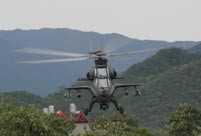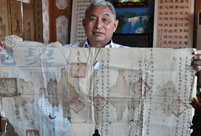

BEIJING, Feb. 16 -- Li Jianhui has a weathered complexion that is not surprising given his 50 years working on a precursor to the staggeringly ambitious water diversion project taking shape in China today.
Since 1964, the 58-year-old has toiled for the Guangdong Yue Gang Water Supply Company, which reroutes water from the Dongjiang River in south China's Guangdong Province to the thirsty bordering island of Hong Kong via a 68-km pipeline.
Five decades since the project's launch, it stands as an early example of China's grand water supply initiatives, which are continuing apace as Beijing and Hebei begin to benefit from the massive south-north water diversion scheme.
The Dongjiang-Hong Kong project is also notable for prospering through 50 years of dramatic political and industrial development. It was launched before China implemented its policy of reform and opening up to the world, before Hong Kong ceased to be a British colony and was returned to China in 1997. The water continued to flow through the Cultural Revolution, and it is a paradigm of cleanliness while other waterways have succumbed to pollution in China's breakneck industrialization.
Li has been a witness to all of this.
In the early 1960s, Hong Kong was in the throes of severe drought, he recalls. "People had water supply once every four days, four hours at a time."
The Hong Kong-based Chinese General Chamber of Commerce and the Hong Kong Federation of Trade Unions asked for help from the Guangdong provincial government.
It agreed to give Hong Kong 20,000 tonnes of tap water for free. Meanwhile, the province appealed to the central government and was allocated 38 million yuan in funding for the Dongjiang-Hong Kong water supply project.
The Dongjiang River originates in east China's Jiangxi Province, with a length of 562 km, and flows to the Pearl River Delta in Guangdong.
Li's job involved supervising a reservoir in a desolate valley near his accommodation in Shenzhen City. "We had to walk almost two hours from the compound to the reservoir," he says. "There was no shuttle bus."
He describes the days as "lonely with beautiful scenery". Li and his colleagues were soundtracked by the susurrus of the river and the silence of the mountains.
There were nine people working at Li's sub-station. They were authorized to use an internal telephone to liaise with their Hong Kong counterparts. Though they could speak in the Cantonese dialect concentrated in the area, they had other communication issues.
Because of China's lack of contact with the outside world at the time, the workers were "required to have political consciousness", as Li puts it. "We were not permitted to talk about anything other than water supply to the Hong Kong side."
The more than 10 thousand manual laborers involved in getting the project operational faced much more basic difficulties than avoiding overstepping the mark in what they said over the phone, according to Li. The work was extremely tough, with Li noting that "there were no modern construction appliances like concrete mixers available when the country was in hard times economically."
 |
 PLA soldiers operating vehicle-mounted guns in drill
PLA soldiers operating vehicle-mounted guns in drill Beauties dancing on the rings
Beauties dancing on the rings Blind carpenter in E China's Jiangxi
Blind carpenter in E China's Jiangxi Top 10 highest-paid sports teams in the world
Top 10 highest-paid sports teams in the world In photos: China's WZ-10 armed helicopters
In photos: China's WZ-10 armed helicopters UFO spotted in several places in China
UFO spotted in several places in China Certificates of land title of Qing Dynasty and Republic of China
Certificates of land title of Qing Dynasty and Republic of China  Cute young Taoist priest in Beijing
Cute young Taoist priest in Beijing New film brings Doraemon's life story to China in 3D
New film brings Doraemon's life story to China in 3D Obama is sowing discontent in S.China Sea
Obama is sowing discontent in S.China Sea Rescuers work through night to reach cruise ship survivors
Rescuers work through night to reach cruise ship survivors Driving through limbo
Driving through limbo Facing down MERS
Facing down MERSDay|Week